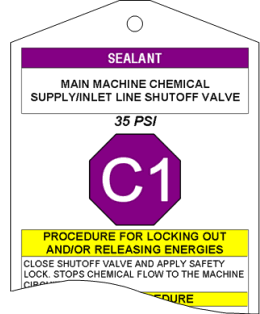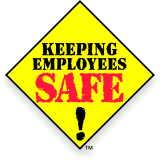Home » Lockout Resources » Energy Source Reference » Chemical Energy Sources
Chemical Energy Sources

Definition of Chemical Energy
Chemical energy pertains to the power related to pressurized liquids that are not water. The pressure can be relatively static (such as holding tanks) or in motion though tubing or hoses. Chemicals may be needed for the equipment to perform a given function, for example, cutting fluid or cooling fluids. In other cases the chemicals are part of the process or final product (e.g. paint, adhesives, etc.)
Associated Chemical Energy Hazards
Per OSHA, there are hundreds of injuries annually due to improper handling of Chemical energy.
Injuries associated with Chemical energy generally consist of the following:
- Eye injuries due to chemical contact
- Burns or suffocation, depending upon the type chemical
- Personnel exposure to hazardous material conditions, depending upon the type of chemical
Proper Lockout/Tagout can virtually eliminate the risk involved with Chemical energy.
Means of Chemical Energy Isolation
Chemical energy must be controlled via a mechanical energy isolating device that physically prevents the transmission or release of the chemical. Specific handling instructions may be required for some chemical. Be aware of any special handling procedures or PPE that specific chemicals may require. Details covering stored chemical energy are available at the Stored Chemical Energy page.
Verifying Absence of Chemical Energy
Verifying the absence of chemical energy after performing Lockout/Tagout can be done by attempting to operate the associated components and by observing the level indicators and/or associated gages to ensure they indicate 0 pressure.
Typical Chemical Energy Isolation Devices
Chemical energy isolation devices may vary in design and configuration. Typical examples include:
- Gate Valves
- Ball Valves
- Butterfly Valves
- Flanges that allow a blank to be inserted
Typical Chemical Energy Lockout Devices
Chemical energy Lockout devices use positive means such as a lock and key to keep the associated energy isolation device in the safe position and prevent equipment energization. Typical chemical energy lockout devices are outlined in the Valve and Pneumatic page.
Lockout Services | Turnkey Programs | Lockout Procedures | Single-Source Procedures | Basic Procedures | Standard Procedures | Advanced Procedures | Custom Procedures | Energy Control Tags | Alternative Protective Measures | Minor Servicing Exception | Online Services | Lockout Audits | Corporate Standards | Lockout Training | Reference Guides | Services RFQ | DEenergizer | Lockout Devices | Electrical | Valve and Pneumatic | Accessories | Group Lockout/Tagout | Devices Index | Devices RFQ | Lockout Resources | OSHA Documentation | NIOSH Documentation | White Papers and Articles | Lockout/Tagout FAQ | Lockout/Tagout News | Lockout/Tagout Signs | Energy Source Reference | Training Material | Library | Glossary | Sitemap | About | Contact Information | Careers | Privacy Policy | Terms of Use | Legal Notice

